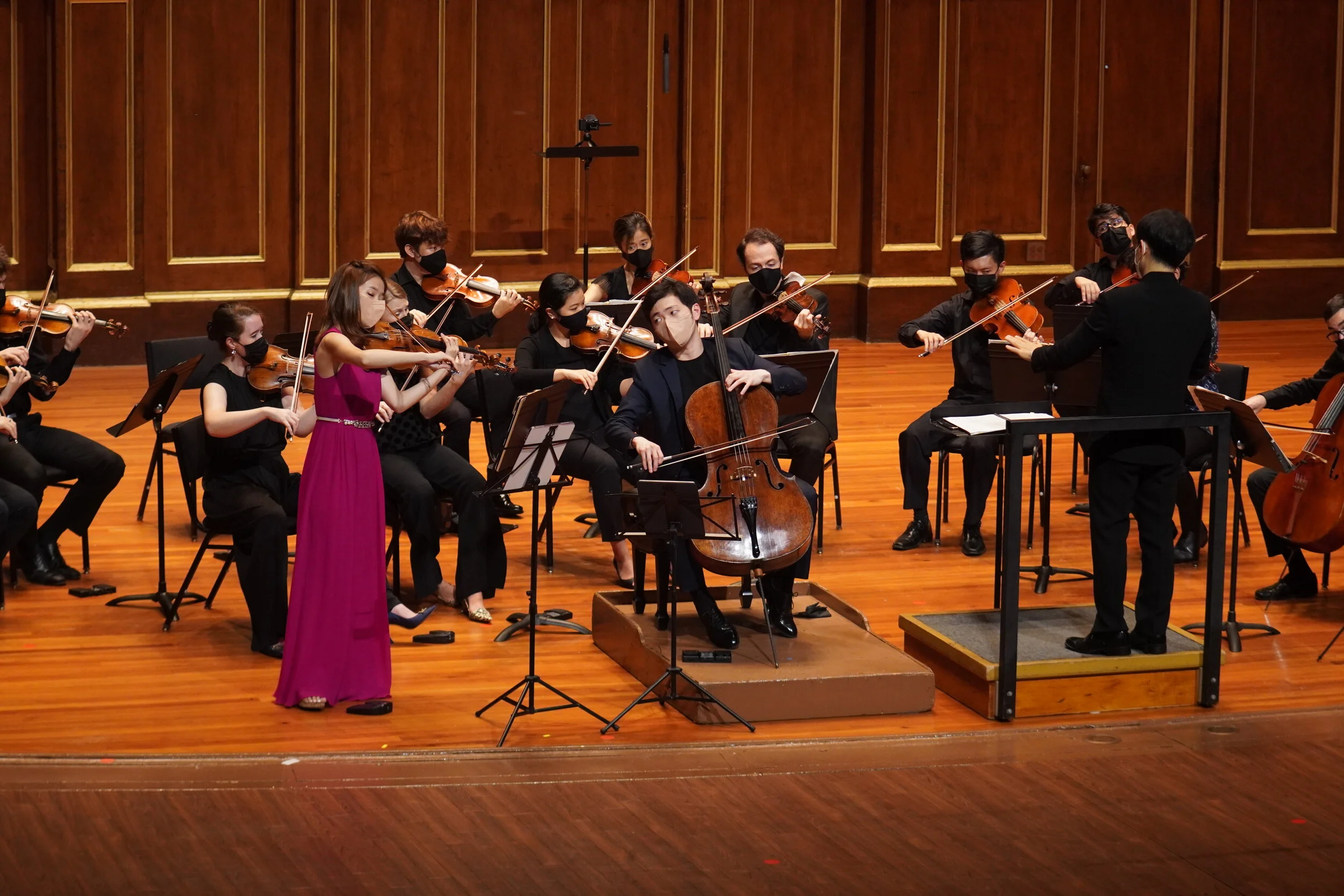Rising Hope for Rising Stars (Sep 20, 2021)
The New York Classical Players, one day after its NYC season opener, came up to Boston for a Jordan Hall debut. The Korean Cultural Society presented an appropriately titled “Rising Stars Concert 2021” to a respectable audience. This young ensemble featured many burgeoning professionals both within and in front of the orchestra, who had emerged out of the rigors of conservatoire with deserved opportunities. Praise should be given to the student ushers tasked with the intimidating prospect of requesting proof of vaccination. They avoided stalling the queue while we scrambled to find digital or printed records.
Rossini wrote his youthfully naïve and imitative Sonata for Strings No. 1 in G Major (the first in a collection of six) at the age of twelve, for musicians close to him: two violinists, a cellist, and amateur double bassist. NYCP’s expanded chamber orchestra of 13 presented a compositional statement of clarity and simplicity with ease. Opening a concert with this work, and capturing the imitative elements of Mozartian energy and Haydn-like humor or virtuosity, set ample challenges. Even with the denser orchestration, the texture remained light and buoyant, with the resonating and warm contrabass of Alexander Bickard solely supporting the nine violinists. Triplet figures exchanged by the violinists in the first movement and the driving 16th notes hint at the energetic drive of Rossini’s later opera overtures.
The viola section, absent from the first work, embraced the spot of concerto soloists, an unusual but well-deserved position for the oft-neglected section. Composer James Ra, in attendance, took on the challenge of writing a work for three viola soloists and string ensemble. In his Concerto for Three Violas & Strings, the three soloists, Jordan Bak, Ramón Carrero-Martinez, and En-Chi Cheng, brought varied timbres to the varied roles, that often divided into three primary ranges—high and lofty, warm and tenor-like, and supportive depth, respectively—or across a textural spectrum. Ra’s knack for expressive, virtuosic string writing came through in the first movement, as the violists imbued molto expressivo.
In the second movement, a figurative jam session, the concertizers traded solos as an alternate approach to three solo violists. Jordan Bak, the first, as a bright commanding presence, colorfully and unpretentiously led the consort, suitably assuming the role of a rising star. Each movement highlighted an aspect of the composer’s deeply held spirituality and the intercessory connection to God. Bak and astute music director Dongmin Kim, leading the movement’s finale, earned adulatory applause.
Celestial elements of the third movement showed kinship to Aaron Jay Kernis’s popular Musica Celestis in string quartet and orchestrated versions. Ethereal harmonics passed between the trio and the orchestra, and a hymn chorale solidified the imagery in the movement title “singing hymns at Heaven’s gate”. The supportive posts of the second and third violists were subsumed by the orchestra at moments, providing focus on the homogenous hymn chorale.
The drive of the fourth movement, “Like to the lark at break of days arising,” came from the trio acting as both a dense wash of emotion and individuated aggressors, often exchanging similar ideas between themselves with minimal distraction from the orchestra. This episodic work concluded with sumptuous chords propelling into emphatic triadic resolutions. Even though all the conscientious soloists executed adeptly, this work could find an alternate life reconfigured as a solo viola concerto, providing that the viola section still received moments to shine.
In an attempt to reconcile with his estranged friend and colleague Joseph Joachim, Brahms dedicated his Concerto for Violin and Cello in A minor, Op. 102 to this renown superstar and his quartet partner Robert Hausmann. While having gotten mixed reviews after the 1887 premiere, the work delivers moments of heightened virtuosity with the nostalgia and emotion of an aging composer. By reducing the full orchestration down to a chamber string arrangement, certain elements of contrast and expansion dissipate, revealing a homogeneity in the accompaniment and highlighting the virtuosity of the solo instruments. Violinist YooJin Jang and cellist Brannon Cho adeptly took on this daunting work with great skill.
In the first movement, Brahms presents his characteristically simple melodic cell, this time a descending three notes, which is then elaborated and expanded upon endlessly, even transforming into Joachim’s musical cryptogram and motto, F-E-A, “Frei aber einsam” (“free but lonely”). Jang and Cho brought individual personalities in their opening while also sleekly becoming one voice. The second movement, with the pared down orchestration, had now the atmosphere of a string serenade, and with it, the pastorale, serene rising and falling gestures. Similar to moments within Brahms’s piano trios, the violin and cello indulge in an expressive togetherness with iteration of the theme in octaves. The soloists acquired balance and reserved passion in front of an attentive orchestra. The very Hungarian finale opens with the cello theme of incessant 8th-note and two 16th-note rhythmic current, which is immediately passed to the violinist. With raw directed ferocity, momentum is spawned by the soloists; and at times, the cellist Cho seemed to be feeding off Jang’s relentless energy. While the arrangement loses some of the weighty dialogue between soloists and orchestra, the performers’ enthusiastic drive provided a refreshing rendition.
In response to the acclaim for these young and driven performers, Jang and Cho provided a surprise duet: playful variations by the obscure Johan Halvorsen. Passacaglia (After Handel), which takes its theme from the finale movement of Handel’s G-minor harpsichord suite, remains playful despit eits dramatic double and triple stops, rapid flourishes, and passages that require complete abandon yet seamless interaction. The featured soloists—five rising stars—impressed with their rigor and passion for adventure.
David Stevens is a Boston-based saxophonist and woodwind doubler, recently graduated from NEC with a double master’s in saxophone performance and music theory. In addition to performing, he spends much of his time as an educator, arts administrator, and theorist.


